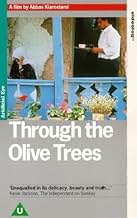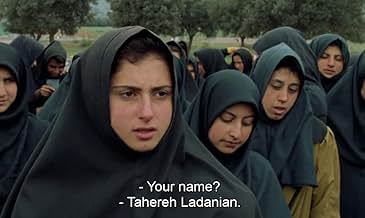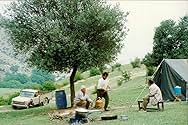CALIFICACIÓN DE IMDb
7.7/10
11 k
TU CALIFICACIÓN
Una descripción de la relación fuera de la pantalla entre los actores que interpretan a los recién casados en la película Y la vida sigue (1992).Una descripción de la relación fuera de la pantalla entre los actores que interpretan a los recién casados en la película Y la vida sigue (1992).Una descripción de la relación fuera de la pantalla entre los actores que interpretan a los recién casados en la película Y la vida sigue (1992).
- Dirección
- Guionista
- Elenco
- Premios
- 5 premios ganados y 6 nominaciones en total
Ostadvali Babaei
- Teacher
- (as Astadouli Babani)
Nosrat Bagheri
- Achiz
- (as Nasret Betri)
Khodabakhsh Defaei
- Teacher
- (as Kheda Barech Defai)
Hossein Jafarian
- Hossein
- (sin créditos)
Jafar Panahi
- Panahi
- (sin créditos)
- Dirección
- Guionista
- Todo el elenco y el equipo
- Producción, taquilla y más en IMDbPro
Opiniones destacadas
First thing: this is the third part in a trilogy. You really need to see "Where is the Friend's House" & "And Life Goes On" first if you want to fully understand this. In short, this is a film about a man making a film of his own journey in search of actors in a film he made earlier. Once you know that, it's not in the least slow or simple, it's a hall of mirrors, as another commentator put it. Frames within frames within frames.
Second thing: Jean-Luc Godard praised Kiarostami's early films, but then felt he'd become too influenced by the international art movie tradition. I don't know if this is a film he liked or disliked, but it sure has a lot of Godard's influence in it - from the director interviewing sundry characters through the conflation of documentary and fiction elements to the use of music, it's like Godard crossed with Satyajit Ray. Not that that's a bad thing.
I don't know if Kiarostami is as original or as striking as some maintain - in many ways this is "Day for Night" transplanted to the Iranian countryside - but it's very watchable, often very funny and the landscape is beautiful.
There also seems to be (in the Iranian context) a subversive subtext to these films. Tradition is held up as hidebound and stupid (the adults in "Where is the Friend's House", the grandmother in this film) while the young are seen improvising their own lives and creating hope in the face of catastrophe. I can't imagine that's too popular with the mullahs, and indeed it seems that Kiarostami has been unable to get a film released in Iran in a decade.
Well worth a view, and it may even inspire you to get out into the world with a digital video camera, but do see the other films (and probably also "Homework") first.
Second thing: Jean-Luc Godard praised Kiarostami's early films, but then felt he'd become too influenced by the international art movie tradition. I don't know if this is a film he liked or disliked, but it sure has a lot of Godard's influence in it - from the director interviewing sundry characters through the conflation of documentary and fiction elements to the use of music, it's like Godard crossed with Satyajit Ray. Not that that's a bad thing.
I don't know if Kiarostami is as original or as striking as some maintain - in many ways this is "Day for Night" transplanted to the Iranian countryside - but it's very watchable, often very funny and the landscape is beautiful.
There also seems to be (in the Iranian context) a subversive subtext to these films. Tradition is held up as hidebound and stupid (the adults in "Where is the Friend's House", the grandmother in this film) while the young are seen improvising their own lives and creating hope in the face of catastrophe. I can't imagine that's too popular with the mullahs, and indeed it seems that Kiarostami has been unable to get a film released in Iran in a decade.
Well worth a view, and it may even inspire you to get out into the world with a digital video camera, but do see the other films (and probably also "Homework") first.
This is the art movie in its essence. Every single minute of this movie is complexly detailed. It was considered by the critics a masterpiece but it could not be nominated for the Academy Awards in the 'Foreign Language Category' because of political problems between Iran and USA at the time (but in 99 'Children of Heaven' was nominated).
It was written by Abbas Kiarostama, who also wrote 'The White Balloon' (another great film) and 'Taste of Cherry' (not so good, although it won the Cannes Palm D'or).
This is a must see for any fan of artfilms. Simply fantastic, amazing and everything else, this movie is a 'sea of creativity'.
It was written by Abbas Kiarostama, who also wrote 'The White Balloon' (another great film) and 'Taste of Cherry' (not so good, although it won the Cannes Palm D'or).
This is a must see for any fan of artfilms. Simply fantastic, amazing and everything else, this movie is a 'sea of creativity'.
Found this film to easily engage my heart without burdening my head with too much technique. Funny, sad, the two sides of the ever encompassing cinema coin. An seemingly effortless exploration of the relationships of men and women, tradition and experience, the old and the somewhat new. And what a beautiful rhythmic last sequence, one of the best of all my moviegoing history.
Abbas Kiarostami's movies along the likes of Mr.Yasujiro Ozu and Edward yang are just like a calm stream of river that keeps on flowing eternally providing neverending relief, life and peace.
If you have enough patience and interest these movies will never bore you, and you could even watch them for many hours if their runtime was even mkre, but at last provide you with a feelgood experience as their movies are so close to our everyday reality that they feel like the stories in them could happen anywhere around us in any part of the world.
Third part of Abbas kiarostami's Koker trilogy providing behind the scenes outlook to "And life goes on...(1992)", almost feels like a complete story in itself about 2 youngsters trying hard to find eachother in all the tension surrounding, after the 1990 earthquake.
The minimalistic director Abbas kiarostami does wonders in almost his every movie that many action directors could not, a true genius.
Through the Olive Trees is a great example of how neo-realistic techniques can show realism in film making. One personal criticism would be the music, but that is purely personal, and takes nothing away from the film. A masterpeice.
¿Sabías que…?
- TriviaThe first film in which Abbas Kiarostami has hired a professional actor (Mohamad Ali Keshavarz who plays the director of the film-within-the-film).
- ConexionesFeatured in Cinema Iran (2005)
Selecciones populares
Inicia sesión para calificar y agrega a la lista de videos para obtener recomendaciones personalizadas
- How long is Through the Olive Trees?Con tecnología de Alexa
Detalles
- Fecha de lanzamiento
- Países de origen
- Sitio oficial
- Idioma
- También se conoce como
- Through the Olive Trees
- Locaciones de filmación
- Productoras
- Ver más créditos de la compañía en IMDbPro
Taquilla
- Total en EE. UU. y Canadá
- USD 40,300
Contribuir a esta página
Sugiere una edición o agrega el contenido que falta

Principales brechas de datos
By what name was Zire darakhatan zeyton (1994) officially released in India in English?
Responda





















